Nexus S and Android 2.3 Review: Gingerbread for the Holidays
by Brian Klug on December 14, 2010 4:08 PM EST- Posted in
- Smartphones
- Samsung
- Nexus S
- Gingerbread
- Android 2.3
- Mobile
Baseband and Cellular
On the far left side of the Nexus S is another region with the indicative flex/tape appearance that belies an antenna. From experimentation, this region is for WiFi and Bluetooth. The active region for the cellular region is at the very bottom of the Nexus S, as it is with the overwhelming majority of other phones.
We ran our normal suite of attenuation tests on the Nexus S and compared to the rest. The Nexus One had a mini antennagate of its own back when it came out, no doubt Google and Samsung both wanted to avoid a similar situation with the Nexus S. The table says it all - attenuation from holding the device is in line with the 15 dBm or so we’re used to seeing. There aren’t any attenuation issues with the Nexus S.
| Signal Attenuation Comparison in dB—Lower is Better | |||||||
| Cupping Tightly | Holding Naturally | On an Open Palm | |||||
| Nexus S | 13.3 | 6.1 | 4.3 | ||||
| Samsung Fascinate | 10.0 | 5.0 | 0.0 | ||||
| Droid 2 | 11.5 | 5.1 | 4.5 | ||||
| BlackBerry Torch | 15.9 | 7.1 | 3.7 | ||||
| Dell Streak | 14.0 | 8.7 | 4.0 | ||||
| Droid X | 15.0 | 5.1 | 4.5 | ||||
| iPhone 4 | 24.6 | 19.8 | 9.2 | ||||
| iPhone 3GS | 14.3 | 1.9 | 0.2 | ||||
| Nexus One | 17.7 | 10.7 | 6.7 | ||||
I did notice however that the Nexus S likes falling back to EDGE from UMTS and HSPA a whole lot. I’ve only had a limited time to play with T-Mobile’s 3G turned 4G network, so I’m not crying foul, but I did notice that voice calls often migrate over to EDGE if you’re in marginal (but not awful) UMTS coverage, and data does the same from time to time. During my battery life call tests, I had to re-initiate the call three times due to the Nexus S falling from UMTS (3G) voice to GSM and not wanting to pollute data. Signal in my office is admittedly on the lower end at -91 dBm, but still within an acceptable range. The phone will automatically hand back on to UMTS, then to HSPA after a while, but the fallback to EDGE seems much more aggressive than I’ve ever remembered any device being.
I’ve run over 100 speedtests in the short three or so days I’ve had the Nexus S in my HSPA+ enabled T-Mobile market. I saw maximum throughput of 5.1 megabits/s down, 0.64 megabits/s up and average speeds of 2.55 megabits/s down, 0.51 megabits/s up over that time using the Speedtest.net application to a sever in the same city.
The Nexus S is a tri-band HSPA device and quad-band GSM device as shown in the table above. Just like the launch-day Nexus One, the Nexus S won’t work on any 3G in the USA except T-Mobile. You’ll get EDGE if you stick an AT&T SIM inside.
| Nexus S - Network Support | |||||
| Tri-Band HSPA | 900 / 1700 / 2100 MHz | ||||
| Quad-Band GSM/EDGE | 850 / 900 / 1800 / 1900 MHz | ||||
| HSDPA/HSUPA | 7.2Mbps / 5.76Mbps | ||||
When the Nexus One came out - before I signed on with AnandTech in this capacity - I wrote that the problem with the Nexus One concept was that the hardware didn’t have a pentaband UMTS radio. The promise was completely carrier-agnostic phone shopping, yet the only choice you could get with 3G UMTS/HSPA support was T-Mobile. Of course, an AT&T version came later, but the problem remained - hardware wasn’t carrier agnostic, so how could the promise ever be a reality? I’m disappointed that the same thing applies to the Nexus S, although this time around there’s no guarantee we’ll get an AT&T version at all. There are obvious engineering challenges to building pentaband UMTS/HSPA hardware, but if Nokia can do it with the N8 and a select few other phones can pull it off, it can’t be that hard.
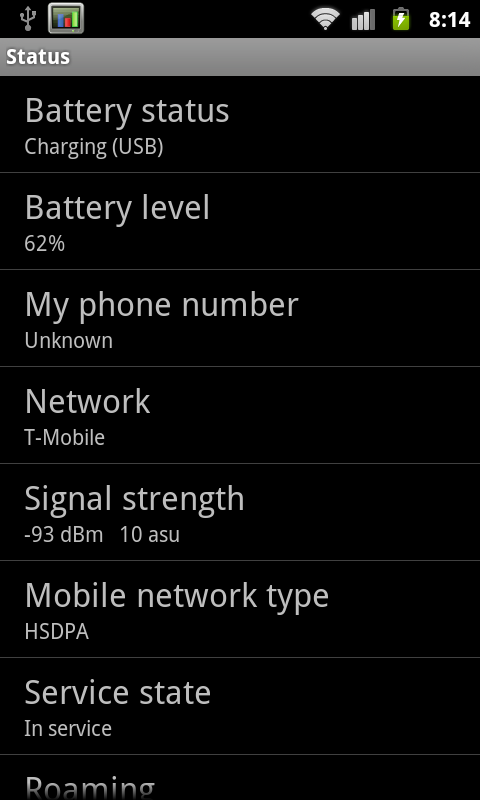
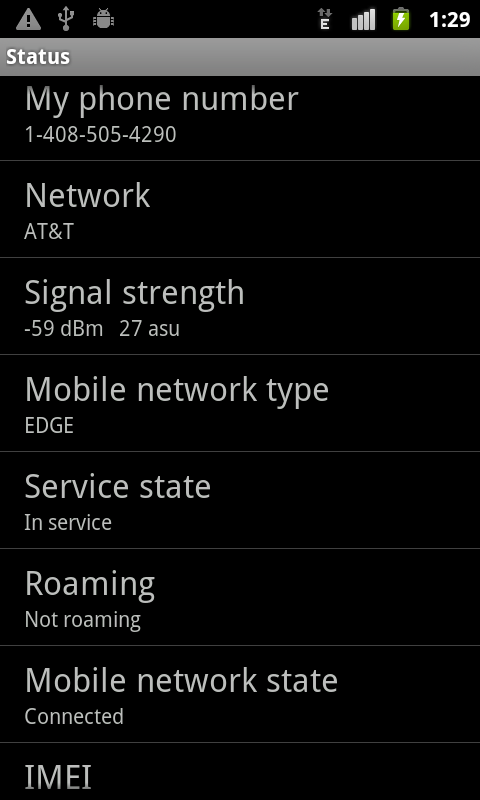
The other thing on everyone’s mind is how much HSPA+ 21.1 differs from HSDPA 7.2 or 14.4 in practice. Well, I’ve been sitting on a myTouch 4G for a while waiting for some T-Mobile service to test with, and in comes a Nexus S with a T-Mobile SIM card. Naturally, I carried the two with me and ran tests at almost the same places. The results are pretty interesting. On the myTouch 4G, I saw maximum throughput of 7.18 megabits/s down, and 0.66 megabits/s up, with an average of 2.75 megabits/s down, and 0.56 megabits/s up.
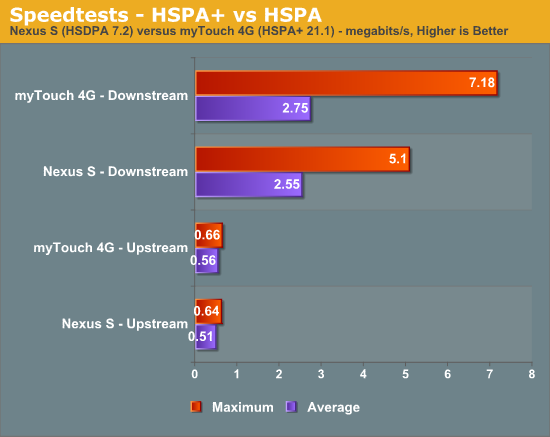
The subtle difference in most cases actually makes sense. The difference between HSDPA 14.4 and HSPA+ 21.1 is just a change in modulation from 16-QAM to 64-QAM. The symbol rates for those two are the same, they just differ in the modulation scheme by a factor of 4 more decision points. Since 64-QAM requires better SNR over 16-QAM, we really only see that modulation scheme when we’re close to the tower. When that’s the case and SNR is really good, HSPA+ of the 21.1 sort does pay off, and you get impressive speeds such as that 7.18 megabit/s speedtest. However, when you’re even just half way out of the cell radius, SNR is most likely no longer good enough for 64-QAM to maintain an acceptable frame error rate, and you’ll fall back to 16-QAM just the same. In reality, HSPA+ only becomes super interesting when MIMO is added into the picture, and even moreso when dual-carrier links are added. MIMO lets us multiplex the signal spatially, and multi-carrier effectively aggregates carriers together for a faster link.
WiFi range on the Nexus S is what I’m used to seeing for smartphones. I make it to the same place right at the curb with the Nexus S as I do other devices. The Nexus S has 802.11 n/b/g support, and I saw it connect at 72 megabits/s on my 802.11n network. In testing, the Nexus S downloaded our local 100 MB PDF over at 15 megabits/s over WiFi.
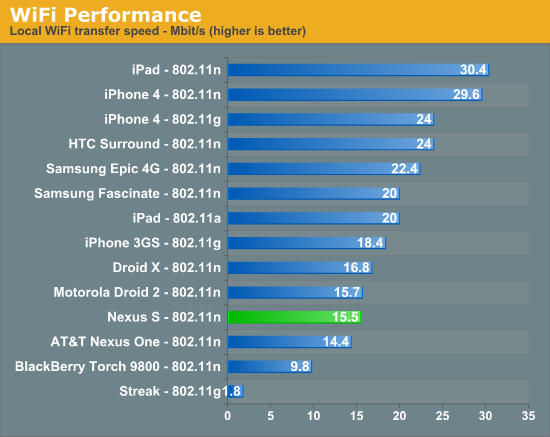
Rounding out this section is a note that the Nexus S suffers from none of the GPS issues that plague the Galaxy S. I tested thoroughly - fixes are fast and accurate over GPS and work like they should using Google location services with WiFi trilateration.


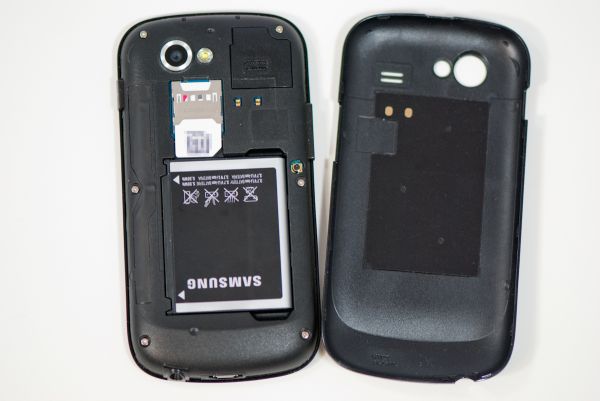
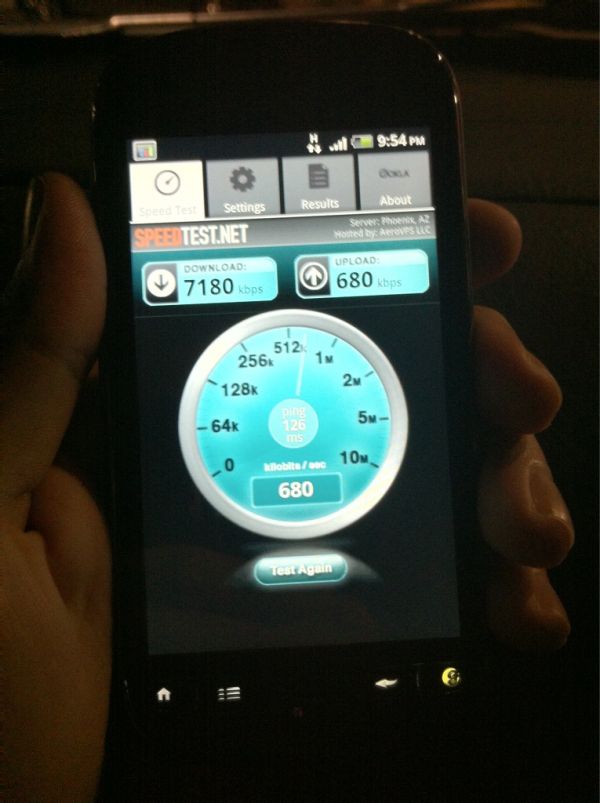








73 Comments
View All Comments
ltcommanderdata - Tuesday, December 14, 2010 - link
I asked this in the previous LG Optimus 7 review and didn't get an answer. I was wondering if your benchmarks for the iPhone and iPad have been updated to use iOS 4.2.1? iOS 4.2.1 introduces Safari 5 compared to Safari 4 in the previous iOS 4.1 so I was interested in seeing what performance benefits there are.Brian Klug - Tuesday, December 14, 2010 - link
Oh interesting, I haven't updated them but will do so soon. I don't know if they'll go into this review, but definitely in the myTouch 4G and LG Optimus One pieces that are coming shortly. Thanks for pointing that out.-Brian
Brian Klug - Tuesday, December 14, 2010 - link
There we go, I've updated the web synthetics graphs (Brmark and Sunspider 0.9) with numbers from iOS 4.2.1. Looks like Brmark saw a nice jump, but Sunspider did virtually nothing.-Brian
DigitalFreak - Tuesday, December 14, 2010 - link
I'd be all over a Nexus if they made one with CDMA and either WiMax or LTE.ltcommanderdata - Tuesday, December 14, 2010 - link
Thanks for the quick response.Just a question on the charts. They mention the older iOS version as 4.2 while the newer one is iOS 4.2.1. Were the older results actually iOS 4.2 since I don't believe that was publicly released. They went directly from iOS 4.1 to iOS 4.2.1.
Brian Klug - Tuesday, December 14, 2010 - link
Oops you're right. I got confused thinking - hmm, what's last the version of iOS I was running - since I played around with the beta for a while. Fixed now ;)-Brian
evan919 - Tuesday, December 14, 2010 - link
Awesome, thanks!sprockkets - Tuesday, December 14, 2010 - link
He took the video with an iphone. Kinda ironic ;)samven786 - Tuesday, December 14, 2010 - link
I was wondering did your nexus s had any random shutdowns? This is known issue on the captivate and the vibrant.Brian Klug - Tuesday, December 14, 2010 - link
Thus far no, it's been speedy consistently. I've been using it (somewhat brutally) nonstop since mid-Friday. I haven't seen it grind to a halt yet.-Brian